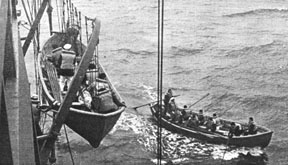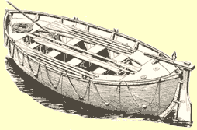Lifeboats, Lifeboat Equipment and Rafts
[As taught to U.S. Maritime Service Trainees in World War II]All articles of equipment for lifeboats must be of good quality, efficient for the purpose they are intended to serve and kept in good condition. Lifeboats must be fully equipped before the vessel leaves port, and the equipment must remain in the boat throughout the voyage. It is unlawful to stow in any boats articles other than those required. All loose equipment must be securely attached to the boat to which it belongs.
Stowage of Boats Aboard Ship
Boats on the starboard side are numbered with odd numbers from forward to aft (1-3-5-7 etc.). Boats on the port side are numbered with even numbers from forward to aft (2-4-6-8 etc.). Boats stowed in nests are numbered from the top down (1, 1A, 1B, etc.).
Maintenance of Lifeboat and Equipment
A man or group of men is especially assigned by the chief mate to take care of and report the condition of the lifeboats each day. At drill each crew member should inspect the boat to which he is assigned and examine its condition as far as his own safety is concerned. In addition to daily inspection of the lifeboats it is required by law that once each year every bit of equipment come off the lifeboat to be examined and overhauled. The entire boat must be overhauled and painted and the equipment must be kept in perfect condition. In wartime, more frequent inspection is expected.
Releasing Gear
The purpose of releasing gear is to permit releasing both of the falls simultaneously as soon as the boat is waterborne, and thus to avert possible mishap.
It consists of two releasing hooks on bridles, one at each end of the boat, connected by a chain or rod running from one end of the boat to the other. The releasing hooks are hinged on pins so that they may be rotated and upset. The chain or rod between the two hooks is equipped with an operating grip in a convenient location near the stem. It is fastened to the releasing hooks in such a manner that a strain on it will cause the hooks to upset and thus free themselves from the falls.
In operation, a strain is put on the chain by pulling the operating grip as soon as the boat is waterborne, upsetting both hooks and freeing them from both falls simultaneously. Releasing hooks connected to a rod running along the floor of the boat are operated by means of a lever, functioning through universal joints, which disengages a pin at each end, releasing the hooks.
Life nets
Life nets are rope nets which hang from the embarkation deck down to the water line. The purpose of the life net is to let the crew climb down into the lifeboat after the boat is water-borne.
Man ropes
Man ropes are attached to the spanner guy which runs from one davit head to the other. On these ropes at three foot intervals are knots to enable seamen to climb down the man rope and into the boat. The main use of the man rope is for the men who are in the boat while it is being lowered, to hold on to, should the boat capsize when it hits the water, or up end in the process of lowering.
Jacob’s Ladder
One or more rope or chain ladders are placed near the boat or embarkation deck so as to be thrown over the side in such a manner that the lower end reaches the boat.
Sea Painter
The sea painter is a manila line three times the length of the distance from the boat deck to the ship’s light load line, not less than 2 3/4 inch in circumference. It is used to sheer the lifeboat away from the ship’s side and to keep the lifeboat near the mother ship to pick up the remaining crew. It is made fast to the lifeboat usually on the second thwart by means of a strap eye and toggle. The other end is made fast to the main deck of the mother ship well forward on the outboard side of everything. It is released by pulling the toggle.
Grab Rail
The metal rail extending 2/3 the length of boat below the turn of the bilge is for survivors to hold on to or for righting an upset boat, if the boat has been overturned in the water.
Use of Personal Equipment
No baggage, such as suitcases and seabags, is permitted in any lifeboat. The only exception to this is a small personal abandon-ship kit carried by the individual seaman. Care should be taken that the abandon-ship kit is not overburdened. Survivors have strongly recommended that cigarettes be set aside to take into boats, and that they be in moisture-proof tins.
General Equipment Of A Lifeboat
Two Boat Hooks -- one used fore and the other aft for holding or shoving off, or for fishing a line out of the water.
One Canvas Hood and Spray Curtain -- used to protect the crew from the spray of the sea and also to provide shade from the sun.
One Ditty Bag -- one canvas bag containing sewing palm, needles, sail twine, marline and marline spike.
One Fishing Kit -- in good condition with hooks, fishing gear and booklet of instruction.
Two Hatchets -- placed in the forward and after ends of the boat on long lanyards for emergency use.
One Life Line -- with seine floats, for men in the water to hold onto.
Two Life Preservers -- for anyone who cannot get to their own or who have lost theirs. They may also be thrown to persons in the water.
One Painter -- 15 fathoms, 2 3/4 inch, secured to the stem for being towed and towing, coiled ready for use.
One Sea Anchor -- with a storm oil container to keep the boat headed into the sea and to spread the oil so that the waves will not break on the small craft.
One gallon of storm oil -- to calm the seas.
One bailer -- usually made of wood or leather to bail the water out of the boat.
One bilge pump -- which works by suction and sucks the water out of the boat below the floor boards.
One two-gallon bucket -- for bailing the boat or for other practical purposes.
Automatic Plugs -- used in draining the boat on the davits.
Twenty-five soft wood plugs -- 3 inches long, 1/4 inch to 3/4 inch taper contained in a canvas bag. These are to plug up bullet holes or for similar purposes.
Six woolen blankets -- to keep the wounded or sick warm or to use for men who had to get away from the ship without any clothes.
One first-aid kit -- in a watertight container containing scissors, bandages, tourniquets, boric lint dressings, absorbent cotton, adhesive tape, safety pins, iodine with brush, ointment for burns, supply of splints and instructions in first aid.
30 fathoms of 15 thread manila line -- for general use.
Mast and sails -- for sailing the boat and reaching land or keeping in the sea lanes where rescue is more likely. The sails are red or yellow in color to make them visible for greater distances.
Oars -- a single banked complement of oars, two spare oars, and a steering or sweep oar (painted a distinguishing color so as to be quickly recognized).
Hand operated propellers -- for extra large lifeboats which operate by mechanical means hereby everyone pushes together and turns aver the hand operated propeller.
Rowlocks -- must have a full set and a half.
Source:
United States Maritime Service Training Manual. War Shipping Administration Training Organization, published for United States Maritime Service by Cornell Maritime Press, 1943, 1944
Official United States Coast Guard Regulations: Lifeboats, Rafts, And Lifesaving Appliances
www.USMM.org ©1998-2003. You may quote small portions of material on this website as long as you cite American Merchant Marine at War, www.usmm.org as the source. You may not use more than a few paragraphs without permission. If you see substantial portions of any page from this website on the Internet or in published material please notify usmm.org @ comcast.net

